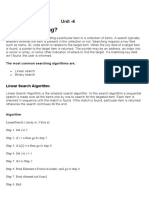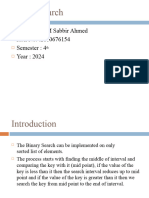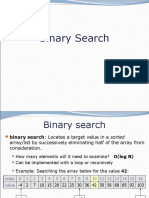0% found this document useful (0 votes)
13 views9 pagesUpdated Binary Search
Binary search is an efficient algorithm for searching sorted arrays, utilizing a divide-and-conquer approach to halve the search space. It has a time complexity of O(log n) in the worst case and is widely applied in various fields such as databases and AI. While faster than linear search, it requires sorted data and can have increased space complexity in recursive implementations.
Uploaded by
meakankshasharma098Copyright
© © All Rights Reserved
We take content rights seriously. If you suspect this is your content, claim it here.
Available Formats
Download as PDF, TXT or read online on Scribd
0% found this document useful (0 votes)
13 views9 pagesUpdated Binary Search
Binary search is an efficient algorithm for searching sorted arrays, utilizing a divide-and-conquer approach to halve the search space. It has a time complexity of O(log n) in the worst case and is widely applied in various fields such as databases and AI. While faster than linear search, it requires sorted data and can have increased space complexity in recursive implementations.
Uploaded by
meakankshasharma098Copyright
© © All Rights Reserved
We take content rights seriously. If you suspect this is your content, claim it here.
Available Formats
Download as PDF, TXT or read online on Scribd
/ 9

























































